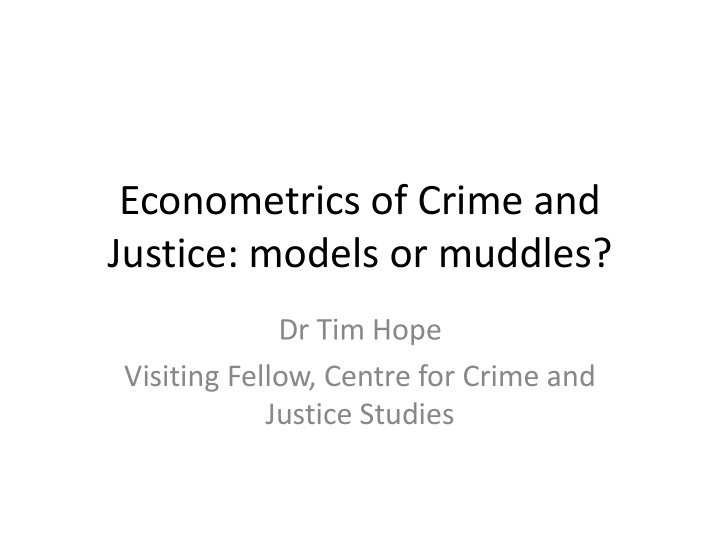



Econometrics of Crime and Justice: models or muddles? Dr Tim Hope Visiting Fellow, Centre for Crime and Justice Studies
The Neo-Classical (Utilitarian) Economic Model after G. Becker • Individual criminal decision-making is a rational calculation based on expected utility • Criminal decision-making is about how individuals allocate their time/labour between legitimate and illegal activity • The decision to commit a crime is a balance between the net gains from legitimate work versus net gains from illegitimate work • The decision is influenced by – the probability and cost of punishment – the probability and gains of legitimate work
Deterrence • General Deterrence : effect of punishment on the general population • Specific Deterrence: effect on those subject to penal sanction • Certainty of punishment : probability of receiving a penal sanction • Severity of punishment : quantity of a penal sanction
Contradictions in the Use of Punishment • General deterrence may deter the general population (i.e. low offender prevalence rate) • Specific deterrence does not deter the offender population (i.e. high reconviction rate) • General deterrence informs sentencing policy more than specific deterrence (legislation versus treatment) • Specific deterrence of the sentenced population is used as an instrument to demonstrate general deterrence to the general population ‘to encourage the others’
Contradictions in the Use of Punishment • Sentencing policy manipulates the severity of punishment (custody, length of sentence) • Increasing the severity of punishment may reduce crime by delivering greater general deterrence • Increasing the severity of punishment may increase crime via the criminalizing effect of punishment (e.g. failure of specific deterrence)
Contradictions in the Use of Punishment • The specific deterrent effect of the severity of punishment (sentence) depends upon the certainty of punishment (arrest and charge) which depends upon the likelihood of detection (policing) • A low probability of detection (low certainty) may cancel the deterrent effect of sentencing
Contradictions in the Use of Punishment • General deterrence works: the general population may over-estimate the certainty of punishment because they place a high value on the cost of punishment (risk-aversion) • Specific deterrence does not work: Persons with prior experience of punishment have a more accurate assessment of both the certainty and the severity of punishment than the general population • Increasing the severity of punishment may not deter crime by offenders (who are supposed to ‘deliver’ general deterrence via specific deterrence) while having no effect on the general population • Increasing the severity of punishment without increasing the certainty of punishment may increase punishment delivered to prior offenders (increasing the failure of specific deterrence) without altering the crime rate (Durlauf and Nagin, 2011)
Contradictions in the Work-Crime Equation • Effect of Crime on Work-Crime – Crime has a positive effect on crime (immediate gratification) – Crime has a negative effect on work (less deferring of gratification) • Effect of Work on Work-Crime – Human capital/work experience has a positive effect on work, protects against low-gratifying work (deferred gratification) – Higher-reward work has a negative effect on crime (more to lose) – long-run gratification of work outweighs short-run gratification of crime (stake-holding in conformity) • Effect of Punishment on Work-Crime – Negative effect on work (reduces future employability/wages) – Positive effect on crime (increases future criminal involvement) – Negative effect on crime (deters present crime, reduces future crime)
Embedding of Work and Crime (path-dependencies) Offending Offending and Working Working <16yrs Crime Education/Training 17-21yrs Crime/punishment Crime Low Education/Training reward work >21yrs Crime/punishment Crime Low Higher reward work reward work
‘Selection Effects’ in the longitudinal Work - Crime Equation • Crime and Punishment select ‘criminals’ over time • Work selects ‘non - criminals’ over time • Respective selection processes create heterogeneity amongst population in work/crime propensities over time • Heterogeneity of experience of work/crime selection processes will moderate/mediate effects of crime prevention through either punishment or rehabilitation • Implied contradictory utilities of work, crime and punishment create heterogeneity and may cancel each other out in linear-causal, temporal models
University of Birmingham Conclusions 2015 • “ Findings suggest that different sentences have a heterogeneous impact across adults and juvenile criminals engaging in violent offences ” – Because of the different longitudinal effects of punishment, and path- dependencies in work and punishment • “For juveniles Non Custodial Sentences seem to be less effective [on crime rates than custodial sentences]” – Custodial sentences act as general deterrent for young people – But youth custody amplifies youth offending and increases likelihood of adult offending • “ For adults Custodial Sentences seem to be less effective [on crime rates than non-custodial sentences] ” – Custodial sentences irrelevant for general deterrence – Repeated custodial sentences inhibit rehabilitation
Conclusion • Utilitarian wishful thinking: remember the Short, Sharp Shock ! • Embeddedness: selection into crime and work • Path-dependencies • Heterogeneity of the population (convicted versus non-convicted) • Need for more complex theories and methods than the neo-classical (and positivist) models
Recommend
More recommend